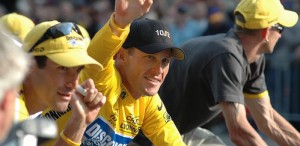 So, you’re going to France in July, and you’re aware that there’s some big bike race that goes on then. But beyond that, you don’t know anything about the Tour de France. Well, pull up a chair, kiddos – this is Tour de France 101.
So, you’re going to France in July, and you’re aware that there’s some big bike race that goes on then. But beyond that, you don’t know anything about the Tour de France. Well, pull up a chair, kiddos – this is Tour de France 101.
The truth is that while you could spend your whole life learning about the intricacies of this popular sport, there’s no need to do that. You can learn enough about the Tour de France to get into the spirit while you’re in France – and perhaps even catch a stage or two in person – without investing in a pair of spandex shorts and memorizing the history of the race. I learned to love cycling in 1996, and although I could talk about it at length for hours with anyone who might be interested (anyone? anyone?), I’ve boiled down the basics of what you’ll need to know to enjoy the spectacle and not be completely in the dark.
Welcome to the Tour de France for Beginners.
First, we’ll start with some cycling vocabulary so you know what I’m talking about further down this page. Then we’ll move on to the basics of the Tour de France, and the various Tour de France jerseys to look out for. And then, if you haven’t completely gone cross-eyed, there’s some Tour de France trivia at the end!
Tour de France Vocabulary
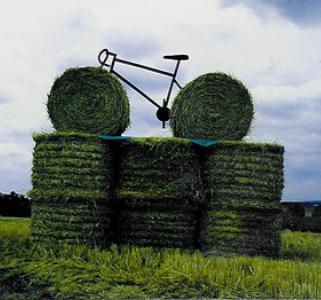 Even if you’re able to catch coverage of the Tour de France in your native language, some of the words you’ll hear are still going to be French. And even some of the English words are confusing if you don’t know what they’re talking about. Here are some of the main words you might hear when you’re listening to race coverage.
Even if you’re able to catch coverage of the Tour de France in your native language, some of the words you’ll hear are still going to be French. And even some of the English words are confusing if you don’t know what they’re talking about. Here are some of the main words you might hear when you’re listening to race coverage.
- allez (ah|LAY) – This French word means “GO!” and it’s what you’ll hear people yelling at the riders as they pass
- attack – A sudden attempt to get away from another rider, often when one rider senses another isn’t able to keep up, in an effort to drop the lesser rider
- bonk – Known as “hitting the wall” in marathon running, this is when a rider completely runs out of energy; often it’s actually a visible phenomenon, when it suddenly looks as if peddling the bicycle up a hill is more than the cyclist can manage
- breakaway – A rider or group of riders that takes off from the front of the pack
- bridge the gap – When a rider or group of riders is attempting to reach a group farther ahead, either a breakaway group or the main field if a rider has been dropped
- chasers or chase group – Riders who are attempting to “bridge the gap” to catch the lead group, also known as a “chase group”
- directeur sportif (spor|TEEF) – A French term, this is the manager of the team, and is akin to a coach in that he’ll dictate strategy for the team
- domestique (doh|mess|TEEK) – A French term, this is a rider who sacrifices any individual honors to the team leader who is in contention to win; these riders are hired specifically for their “work horse” ability to protect the interests of the team leader
- drop – To leave another rider or riders behind by attacking; dropped riders expend much more energy to catch back up to a group, and are therefore less able to counter any subsequent attacks
- G.C. – Stands for “General Classification,” and is the overall standings for the race on any given day
- hors categorie – A French term (first word is pronounced like “oar”), this is the classification given to the most difficult mountain climbs; it’s often abbreviated as H.C.
- lead out – An often sacrificial move where one rider begins a sprint to give a head start to a teammate on his rear wheel, who then comes around at an even faster speed to take the lead
- maillot (my|OH) – A French term, it means “jersey;” you’ll hear it when they’re talking about the leaders of the different competitions, like the “maillot jaune,” or “yellow jersey,” as the race leader
- pace line – A line of riders taking orderly turns at the lead and staggered so that each rider will get maximum protection from the wind
- peloton (PELL|uh|tahn)- A French term, this is the main group of riders, also known as the “pack,” or “bunch” or “main field”
- stage – An individual day’s race in a longer event which lasts over several days
- time trial – An individual race against the clock where riders begin at specific intervals and are attempting to ride the same course as everyone else in the shortest possible time; often called the “race of truth;” a variation sometimes seen in races like the Tour de France is the team time trial, where an entire team will race together, the clock stopping only when the 5th racer crosses the finish line
Tour de France Basics
- Distance: Varies year to year, generally more than 3,500km (2,200mi) total
- Duration: Roughly 3 weeks of racing; recently it’s a 23-day event with 2 rest days (so 21 days of racing)
- Objective: Finish the race with the lowest accumulated time
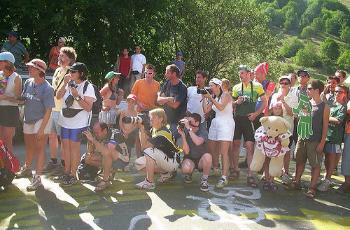 The Tour de France is a “stage race,” meaning that each day of racing is a “stage” with an individual winner but the total time raced over all the stages is what adds up to determine who the winner of the entire Tour is. The overall winner at the very end is determined by cumulative time – each day the rider’s times are added up and at the end of the race the one who has ridden all the stages in the least amount of time is the winner. This rider doesn’t even have to have won a single stage of the race in order to win the whole thing.
The Tour de France is a “stage race,” meaning that each day of racing is a “stage” with an individual winner but the total time raced over all the stages is what adds up to determine who the winner of the entire Tour is. The overall winner at the very end is determined by cumulative time – each day the rider’s times are added up and at the end of the race the one who has ridden all the stages in the least amount of time is the winner. This rider doesn’t even have to have won a single stage of the race in order to win the whole thing.
But some riders will never be in contention to win a Tour de France – so why do they participate? For some of them, there are competitions within the Tour that can give them a huge amount of prestige. If you think of the entire three-week race as an umbrella, you can picture several other smaller umbrellas underneath it which are the competitions within the competition, so to speak. These can be for things like the best overall young rider or the best overall mountain climber, and each individual day’s race (each stage) can be considered one of these sub-competitions, too. So while there’s only one guy standing on top of the podium in Paris, there are lots of opportunities to win things in the Tour de France – and winning anything during the Tour is a major addition to a cyclist’s resume.
What this means from a spectator’s point of view is that while it can be fun to follow the race from start to finish for the whole three weeks, you don’t need to wait that long to see someone raise a bouquet of flowers on the podium and get kissed by the pretty Podium Girls. Every day of racing ends with a podium presentation for the leaders on that day, as well as that day’s stage winner. So enjoy as much (or as little) of the Tour de France as you like.
Tour de France Jerseys
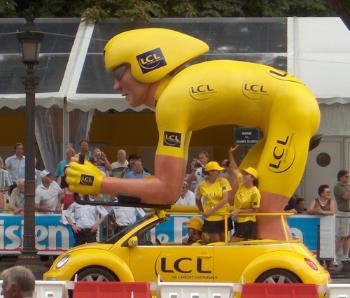 These are the jerseys riders in the Tour de France are trying to win. They can change hands daily, but the guy who’s wearing each jersey on the last day of the race is the overall winner of that jersey. The yellow and white jerseys are based on cumulative time, while the green and polka-dot jerseys are based on cumulative points awarded.
These are the jerseys riders in the Tour de France are trying to win. They can change hands daily, but the guy who’s wearing each jersey on the last day of the race is the overall winner of that jersey. The yellow and white jerseys are based on cumulative time, while the green and polka-dot jerseys are based on cumulative points awarded.
- Maillot Jaune – Yellow Jersey, worn by the overall race leader each day
- Maillot Vert – Green Jersey, worn by the rider who has accumulated the most “points” each day (points are awarded at sprints, so this is generally considered the sprinter’s jersey)
- Maillot a Pois Rouges – Polka-Dot Jersey, worn by the rider who has performed the best over the classified climbs each day; this rider is also called the “King of the Mountains”
- Maillot Blanc – White Jersey, worn by the best-placed overall rider under the age of 25 each day; this is known as the “Best Young Rider” competition
Tour de France Trivia & Tidbits
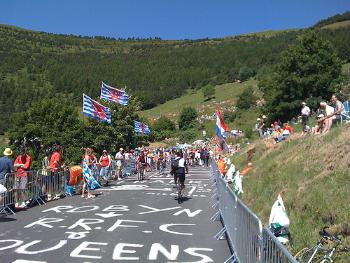
- Each day, the cyclist who’s in the lead overall and gets awarded the yellow jersey for that day also gets a lion stuffed animal as part of his prize. Why? The sponsor of the yellow jersey is the French bank, Credit Lyonnaise. Get it? Lyonnaise – lion.
- The rider in last place each day on the overall G.C. is called the “lanterne rouge,” or “red lantern,” referring to the old red lights which used to hang on the caboose (the last car) of trains. There are websites dedicated to the lanterne rouge each year – not to mock them, but to point out that although they came in last, they could probably still kick most cyclists’ asses.
- The journalists who follow the Tour de France vote at the end of every day and award one rider the designation of “Most Aggressive Rider” – but this isn’t for someone who’s pulled on the boxing gloves. This award goes to the rider who put in the most attacks during the day, and you can pick him out because the number on his jersey the next day is red numbers on white instead of black numbers on white.
- Cycling fans who line the roadsides often paint messages to their favorite riders on the roads themselves (you’ll see painted roads all along the Tour route). One iconic image to look out for is the pitchfork, which is painted by Didi the Devil – he’s a big-time cycling fan from Germany who’s actually sponsored. He paints pitchforks in several places leading up to where he actually positions himself that day, and you can’t miss him. He’s the big bearded guy wearing a devil’s costume, complete with red spandex tights.
>> Read an abbreviated Tour de France history, and check out these spectator’s tips for the Tour de France – and if you’re hooked and want to know more, the Wikipedia entry on the Tour de France is actually really comprehensive.
 So, you’re going to France in July, and you’re aware that there’s some big bike race that goes on then. But beyond that, you don’t know anything about the Tour de France. Well, pull up a chair, kiddos – this is Tour de France 101.
So, you’re going to France in July, and you’re aware that there’s some big bike race that goes on then. But beyond that, you don’t know anything about the Tour de France. Well, pull up a chair, kiddos – this is Tour de France 101. Even if you’re able to catch coverage of the Tour de France in your native language, some of the words you’ll hear are still going to be French. And even some of the English words are confusing if you don’t know what they’re talking about. Here are some of the main words you might hear when you’re listening to race coverage.
Even if you’re able to catch coverage of the Tour de France in your native language, some of the words you’ll hear are still going to be French. And even some of the English words are confusing if you don’t know what they’re talking about. Here are some of the main words you might hear when you’re listening to race coverage. The Tour de France is a “stage race,” meaning that each day of racing is a “stage” with an individual winner but the total time raced over all the stages is what adds up to determine who the winner of the entire Tour is. The overall winner at the very end is determined by cumulative time – each day the rider’s times are added up and at the end of the race the one who has ridden all the stages in the least amount of time is the winner. This rider doesn’t even have to have won a single stage of the race in order to win the whole thing.
The Tour de France is a “stage race,” meaning that each day of racing is a “stage” with an individual winner but the total time raced over all the stages is what adds up to determine who the winner of the entire Tour is. The overall winner at the very end is determined by cumulative time – each day the rider’s times are added up and at the end of the race the one who has ridden all the stages in the least amount of time is the winner. This rider doesn’t even have to have won a single stage of the race in order to win the whole thing. These are the jerseys riders in the Tour de France are trying to win. They can change hands daily, but the guy who’s wearing each jersey on the last day of the race is the overall winner of that jersey. The yellow and white jerseys are based on cumulative time, while the green and polka-dot jerseys are based on cumulative points awarded.
These are the jerseys riders in the Tour de France are trying to win. They can change hands daily, but the guy who’s wearing each jersey on the last day of the race is the overall winner of that jersey. The yellow and white jerseys are based on cumulative time, while the green and polka-dot jerseys are based on cumulative points awarded.